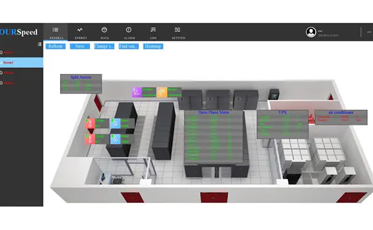Views: 0 Author: Site Editor Publish Time: 2025-06-11 Origin: Site








Environmental monitoring is the process of systematically collecting data about specific environmental parameters to understand and manage the effects of natural and human activities on the environment. These parameters may include air quality, water purity, soil composition, noise levels, and radiation presence. Monitoring involves the use of various tools and techniques to detect pollutants, measure ecological changes, and ensure compliance with environmental regulations.
This practice plays a fundamental role in sustaining environmental health, informing policy decisions, and ensuring public safety. It provides critical insights into how environments change over time and identifies emerging threats. In a world facing climate change, deforestation, urbanization, and industrial pollution, continuous environmental monitoring allows for early detection of problems and proactive management.
Most people are unaware that environmental monitoring surrounds them daily. From public infrastructure to private businesses, monitoring systems are constantly in action. For example, indoor monitoring systems in office buildings detect humidity, temperature, and smoke to maintain safety and comfort. Cities deploy air quality monitoring stations to measure pollutants and warn citizens about smog levels.
Meanwhile, water treatment plants run real-time monitoring of contaminants to ensure that tap water remains safe for consumption. Agricultural areas use soil moisture sensors to optimize irrigation and preserve water. Even smart homes now incorporate basic environmental sensors to alert users to gas leaks, abnormal humidity, or hazardous temperature changes.
In industrial settings, companies such as Guangzhou Speed Technology Co., Ltd. offer comprehensive environmental monitoring systems capable of monitoring multiple parameters simultaneously. These systems can automatically send alerts through SMS or email when abnormal conditions are detected, helping to reduce downtime, prevent equipment damage, and minimize health risks.
The purpose of environmental monitoring is multifaceted:
Assess Environmental Health: Identify pollution levels and the presence of harmful substances.
Ensure Regulatory Compliance: Meet legal requirements set by environmental agencies.
Inform Public Policy: Provide data that influences regulations and environmental laws.
Early Warning Systems: Detect natural disasters or chemical leaks before they become catastrophic.
Support Sustainable Development: Provide data necessary for sustainable land use, agriculture, and urban development.
By monitoring changes and detecting anomalies early, stakeholders can mitigate harmful effects, preserve ecosystems, and protect human populations from exposure to dangerous substances.

Air quality monitoring involves measuring pollutants in the atmosphere that can affect health, climate, and infrastructure. The presence of airborne contaminants such as nitrogen dioxide (NO2), sulfur dioxide (SO2), ozone (O3), carbon monoxide (CO), and particulate matter (PM2.5, PM10) is of major concern, particularly in urban and industrial regions.
Monitoring Methods and Tools:
Fixed ambient air quality monitoring stations
Portable air sensors for mobile use
IoT-enabled wireless air quality sensors
Satellite-based remote sensing
Applications:
Governmental agencies use air quality indices to inform citizens.
Industrial facilities track emissions to avoid fines and comply with laws.
Schools, hospitals, and workplaces use indoor air monitors to ensure safe environments.
The collected data can be analyzed to reveal long-term trends, which helps shape regulations aimed at reducing air pollution and its health consequences.
Water monitoring ensures that lakes, rivers, oceans, and drinking water systems are free from contaminants. This is vital for both public health and ecological sustainability.
Key Parameters:
pH level
Dissolved oxygen (DO)
Electrical conductivity
Biological and chemical oxygen demand (BOD, COD)
Turbidity and suspended solids
Presence of pathogens or heavy metals
Monitoring Tools:
Multiparameter water probes
Real-time remote sensing buoys
Laboratory chemical analysis
In-line monitoring sensors in water treatment plants
Applications:
Municipal water supplies
Industrial effluent management
Aquatic habitat preservation
Agricultural runoff assessment
Water monitoring plays a critical role in controlling waterborne diseases, ensuring safe drinking water, and maintaining aquatic biodiversity.
Soil monitoring examines the composition, quality, and health of the soil. It is particularly relevant in agriculture, construction, mining, and land development.
Key Factors Analyzed:
Soil pH and moisture
Nutrient levels (N, P, K)
Heavy metal contamination
Salinity and organic matter content
Monitoring Methods:
Soil sample analysis in labs
On-site test kits
Spectrometry and chromatography
Remote sensing technologies
Applications:
Precision farming
Brownfield site reclamation
Erosion control and watershed management
Proper soil monitoring can prevent land degradation, guide fertilization practices, and ensure safe construction sites.
Noise pollution is a growing concern in urban environments. Noise monitoring measures sound levels to evaluate compliance with legal thresholds and identify sources of disturbance.
Key Elements:
Sound pressure levels (dB)
Frequency spectrum analysis
Temporal noise patterns
Monitoring Tools:
Sound Level Meters (SLM)
Permanent noise monitoring terminals
Personal dosimeters for occupational health
Applications:
Urban planning and zoning
Construction and transportation projects
Workplace noise exposure analysis
Excessive noise can lead to hearing loss, stress, and sleep disturbances. Regular monitoring helps in designing noise abatement strategies and safeguarding public health.
Radiation monitoring focuses on detecting ionizing radiation such as alpha, beta, gamma, and X-rays. It is essential in nuclear energy, healthcare, research, and defense industries.
Radiation Sources:
Nuclear power plants
Medical diagnostic equipment
Industrial radiography
Natural background radiation
Monitoring Instruments:
Geiger-Müller counters
Scintillation detectors
Dosimeters (TLDs and film badges)
Real-time digital radiation sensors
Applications:
Worker safety in nuclear and medical facilities
Environmental impact assessments
Emergency preparedness for radiological events
Radiation monitoring ensures safe exposure limits and rapid response during leaks or accidents.
Each type of environmental monitoring contributes a piece to the broader puzzle of environmental stewardship. Air, water, soil, noise, and radiation monitoring systems are interconnected in their goal to protect life and promote sustainable development.
Companies like Guangzhou Speed Technology Co., Ltd. provide integrated monitoring solutions that combine various sensor types into a single platform. These systems enable real-time analysis, automated alerts, and historical data tracking, which are invaluable tools for environmental engineers, safety officers, facility managers, and government agencies.
By understanding and implementing the right types of environmental monitoring, industries and communities alike can proactively manage environmental risks, meet compliance standards, and ensure a healthier future for generations to come.